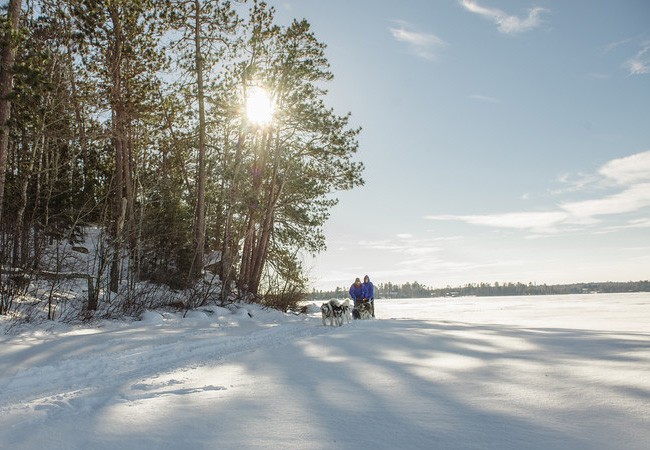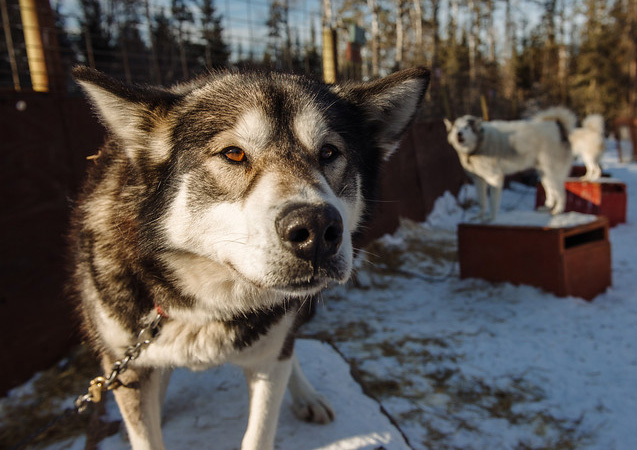
This story was sponsored by the Campaign to Save the Boundary Waters. It’s the last of a five-part series on the Heavy Table telling the story of Ely, its economy, and a special wilderness meal created by Chef J.D. Fratzke of The Strip Club Meat and Fish.
The friendship between humans and dogs goes back at least 11,000 years; DNA evidence isn’t completely clear, but we’ve been running with our four-footed friends for a long time. You can lose sight of some of that relationship’s wild roots when you’re cleaning up after Rex in an urban dog park, but when you’re on the back of a dogsled, speeding across frozen lakes in the Boundary Waters, the primal beauty of cross-species teamwork is as vivid as it was in 9,000 B.C.
The purebred Canadian Eskimo dogs of Wintergreen Dogsled Lodge offer the thrill of Arctic survival with the security of an operation that’s been running smoothly for thirty years. If you visit the kennels on a sledding day in winter, you’ll witness a scene that resembles a canine hive — dogs being attached to and unattached from sleds, guides orienting visitors, and a constant hum of intense, joyous activity. It’s clear that everyone is working hard, but it’s clear, too, that everyone — dogs included — is having quite a bit of fun.

“It’s all about the dogs,” says Wintergreen owner Paul Schurke (above). “The dogs are so affectionate and fun that people enjoy having hang time with the dogs as much as they do sledding through the winter woods here.”
Each dog has its own role to play. “They’re not just snowmobiles with fur; they’re all distinct individuals with unique personalities,” says Schurke. “Even in a very short stay here, people get to know the dogs, and when they come back, they ask for ‘their’ dogs: They want Romeo, or they want Stoney … and they want Prada. … And they get pretty wrapped up in their dogs. It’s such an amazing instinct — [the dogs] just live to pull. You put ’em in a harness, and off they go.”

Wintergreen is an outgrowth of Wilderness Inquiry, which Schurke founded in 1978 with a classmate from St. John’s. Wilderness Inquiry focuses on providing wilderness adventures for people with disabilities.

“It took off in a big way, so we looked for a way to do the program year-round,” says Schurke. “We thought that maybe dog teams would be a way to accommodate people with mobility impairments. But we didn’t know anything about dog teams, so we asked around and got sent back into the woods to this little log homestead in the middle of nowhere where a recluse lived, running dog teams. He happened to be [environmentalist and polar explorer] Will Steger, and we hooked up and became close friends and then business partners. We went into the Arctic on our various polar trips, and then his little business became my little business.”
That little business now includes 60 dogs that run about 60 miles of trails that connect in the winter. About 500 people visit each season to take about 100 trips, many of which involve dogsled camping up and down the Boundary Waters. One of the lodge’s advanced trips “cruises up and down the international border [with Canada],” Schurke says.

The winter timing of Schurke’s work — and of the other seven dogsledding businesses that make Ely the dogsledding capital of the continent — helps keep the tourist town alive during what would otherwise be a dead season. Wintergreen lodge operates in Minnesota from December through March and runs trips in the Arctic in April and May.
“[Dogsledding] accommodates marginal winter conditions — skiing and snowmobiling, that tourism thrives on deep powder,” says Schurke. “But dogs aren’t that discriminating. If there are two inches of white out there, they’re ready to roll; they don’t need two feet of powder. And with winter changing, dogsledding can still do very well. … It’s small potatoes compared to the quarter million people who come here to go canoeing in the Boundary Waters in the summer, but it’s enough to keep the lights on in the hotels and restaurants in town, and it’s certainly a big part of Ely’s mystique and cachet.”

All of what Schurke and his family have built is under threat, however, as sulfide-ore copper mining threatens the watershed of the Boundary Waters.
“[Sulfide mining] is our worst nightmare,” he says. “And unfortunately, we’re at ground zero here. Just three miles through the woods is where they’re proposing to put the world’s largest mine. Miles of pipes, and excavation, and haul roads, and tailings pits. In addition to the landscape devastation, there’s the noise and the dust, which will impact the tourism in a big way.”
Even more alarming is the potential impact on the watershed, itself. “It’ll leech right through our lake, as it’s all just upstream for us and has the capacity to render this entire chain of lakes that lie downstream from the proposed mine into a biological dead zone,” Schurke says.

“What folks have a tough time wrapping their heads around is that once [miners] crack into the sulfide ore body and unleash this chemical chain reaction, it continues to percolate sulfuric acid into the watershed forever. There’s a region in Spain called Rio Tinto. The Romans, attempting to mine copper 1,500 years ago, cracked into the sulfide body and unleashed the perpetual chain reaction, and the river has run red ever since.”
Schurke puts the stakes into a global perspective when he considers the threat to the Boundary Waters:
“I think Minnesotans, in general, take for granted that we have this parcel of American real estate that shines heads and shoulders above most any other,” says Schurke. “It’s the most beloved, most popular, most heavily visited of the 680 protected wilderness areas in America. Beyond that, here we are: Within 50 miles of where you’re standing, there’s 2,000 lakes, most of them clean enough that you can dip a cup in them and drink. There’s probably nowhere else on the planet that can be said. This wilderness area is unique among ecosystems in the U.S. in that all the parts are still in place, the entire chain of life.”


